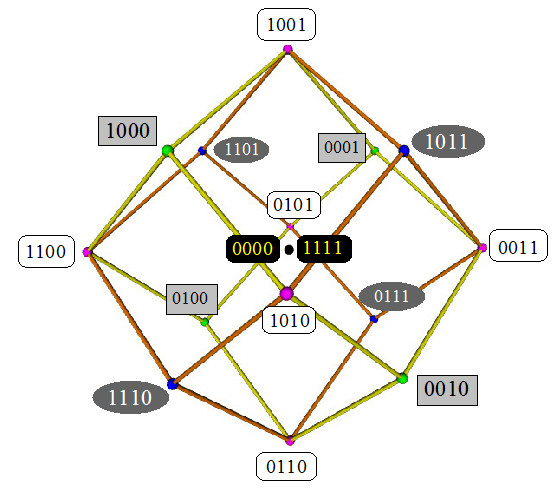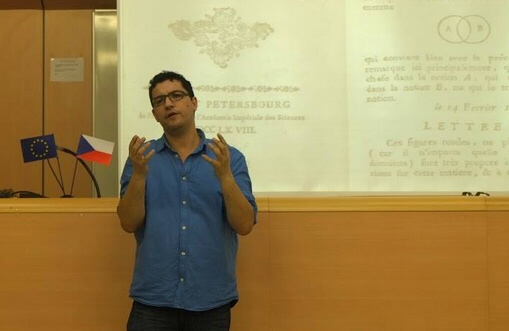Workshop on Logical Geometry and its Applications
WoLGA at UNILOG 2018 (Tuesday June 26, 2018)

UNILOG 2018
The Sixth World Congress and School on Universal Logic
Vichy, France, June 16-26, 2018.
description
Aristotelian diagrams are compact visual representations of the elements of some logical, lexical or conceptual field, and various logical relations holding between them (e.g. contradiction and contrariety). These diagrams have a rich history in philosophical logic, which can ultimately be traced back to the works of Aristotle and Apuleius. Without a doubt, the oldest and most widely known example is the so-called ‘square of opposition’ for syllogistics, but throughout history, authors have also developed larger, more complex diagrams, such as hexagons, octagons, and even three-dimensional diagrams. In contemporary research, Aristotelian diagrams have been used in nearly all subbranches of logic, such as modal logic, various families of non-classical logics, probabilistic and fuzzy logic, consequential logic, and logics of rational agency. Furthermore, because of the ubiquity of the relations that they visualize, Aristotelian diagrams are also frequently used outside of logic, in disciplines such as philosophy, linguistics, computer science, law, cognitive science, and natural language processing.
In recent years, Aristotelian diagrams have also begun to be studied as objects of independent logical and diagrammatic interest, giving rise to the burgeoning field of logical geometry. Rather than focusing on the specific details of any given application, logical geometry aims to develop a systematic theory of Aristotelian diagrams in general. On the logical side, it studies topics such as information level, logic-sensitivity and the interplay between Aristotelian, duality and Boolean structure; on the visual/geometrical side, it is concerned with informational vs. computational equivalence in Aristotelian diagrams, and with analyzing these diagrams as purely geometrical entities (in terms of symmetry, Euclidean distance, polyhedral duality, etc.).
call for papers
The Workshop on Logical Geometry and its Applications (WoLGA) at UNILOG 2018 aims to deepen our theoretical understanding of the logical and diagrammatic behavior of Aristotelian diagrams, as well as to broaden our perspective on their (historical and contemporary) applications. Relevant topics include (but are not restricted to):
- Aristotelian diagrams for non-classical logics
- Aristotelian diagrams and metalogical considerations
- the interplay between Aristotelian and duality relations
- the interplay between the Aristotelian relations and Boolean structure
- probabilistic interpretations of the Aristotelian relations
- relations between (families of) Aristotelian diagrams
- Aristotelian diagrams from the perspective of diagram design
- various kinds of symmetry in Aristotelian diagrams
- logical and geometrical distance in Aristotelian diagrams
- case studies on Aristotelian diagrams used in medieval logic (Western and Arabic)
- case studies on Aristotelian diagrams used by Modern logicians (e.g. Keynes, Carroll)
- case studies on contemporary uses of Aristotelian diagrams in logic
- case studies on contemporary uses of Aristotelian diagrams in other disciplines (e.g. computer science, linguistics)
A one-page abstract should be sent via email before October 5th, 2017 (extended deadline!) to: lorenz.demey@kuleuven.be and hans.smessaert@kuleuven.be.
Notifications will be sent out by November 15th, 2017.
keynote speaker

Amirouche Moktefi
Tallinn University of Technology, Estonia
Lewis Carroll's Seven Charts (and Many Others)
abstract
programme
| 08h30-08h45 | Presentation of the workshop | |
| 08h45-09h30 | Amirouche Moktefi Tallinn University of Technology, Estonia |
'Lewis Carroll's Seven Charts (and Many Others)'abstract |
| 09h30-10h00 | Fabien Schang Universidade Estadual de Maringà, Brazil |
'End of the Square?' abstract |
| 10h00-10h30 | Saloua Chatti University of Tunis, Tunisia | 'Logical Oppositions in Avicenna's Hypothetical Logic' abstract |
| 10h30-11h00 | Coffee Break | |
| 11h00-11h30 | Dany Jaspers KU Leuven - Campus Brussels, Belgium |
'On the Interaction of Tense and Aspect - Merging Kites'abstract |
| 11h30-12h00 | Daniel Wenz RWTH Aachen, Germany |
'Category Theory and Logical Geometry - Is a Commutative Diagram an Aristotelian Diagram?' abstract |
| 12h00-12h30 | Jens Lemanski FernUniversität Hagen, Germany |
'Squares, Cubes and Circles - Sketches of Oppositional Geometry between Geulincx and De Morgan'abstract |
| 12h30-12h45 | General Discussion |
organisers
-
Lorenz Demey
Center for Logic and Analytic Philosophy, KU Leuven, Belgium
http://www.lorenzdemey.eu -
Hans Smessaert
Department of Linguistics, KU Leuven, Belgium
http://wwwling.arts.kuleuven.be/ComForT/hsmessaert/